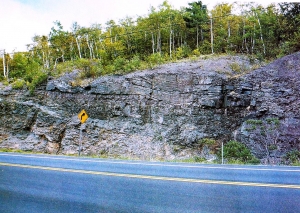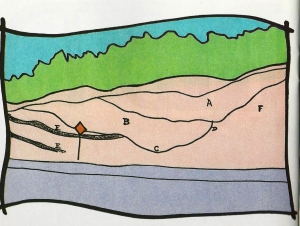A River of Rock
The Greenville Press
Updated by Robert and Johanna Titus
One of the most scenic descents out of the Catskills is along Rte. 23, downhill from East Windham. To your left is the vast expanse of the upper Hudson Valley stretching, it would seem, forever. We enjoy a good view as much as anybody, but when we travel along this road, today’s scenery has to compete with an ancient one. There are a many excellent, large exposures of bedrock along the way. They are all of an eye-catching red and thus are typical Catskill lithologies.
Brick red is the emblematic rock color of the Catskills bedrock. It is the color of the red soils and sediments that accumulated on the great Catskill delta complex of the Devonian time period. In your imagination, take yourself back almost 400 million years to the Devonian time. All around you are the low swampy bayous of a great delta. It’s an ancient version of Louisiana. To the east a great mountain range rises above the horizon. This is an ancient version of the Himalaya. There is a lot of imagery in these old Catskill Delta deposits and this stretch of Rte. 23 may be one of the best locations to learn how to interpret them. And, of course, we don’t just mean learning to make cold scientific judgments about the rock, but to really travel through time to this place as it once was.
Heading up the road from the south, watch for the Cornwallville Road. Just past it is a parking area with a fine panoramic view to the northeast. The view certainly deserves some attention, but we are here to see the rocks. Across the road and between 0.1 and 0.2 miles farther uphill is a fine and very typical outcropping of the Catskill Delta. As you approach it, watch for two striking channel-form structures (A&B on picture). These are actually the cross sections of two Devonian rivers, stacked one upon the other. The upper channel is composed of massive beds of sandstone, the very sands that filled the old channel. This channel eroded its way into an even older channel (A); the lower one is composed of thinner-bedded sandstones. At the bottom of this river of rock can be seen a deposit of gravel (C), it was carried here by strong currents and left at the bottom of the channel. To the right is a steep bank margin (D), this was probably the erosive side of the river. Beyond that is a sequence of red sandy shales (F). These sediments accumulated upon the floodplain, probably during floods. Floodplain deposits, of our Devonian time, were turned red by oxidation. That’s common throughout the Catskills and the origin of that brick red color that I extolled earlier.
To the left of the channels you might notice some dark, sometimes rusty-looking horizons (E). These strata are thinly bedded, just laminations. Dark sediments, like these, were never oxidized, they were waterlogged instead. Floodplain organic matter was preserved and darkened the beds. This appears to be a floodplain swamp. Below it you can see a peculiar horizon. It has an olive color with many blotches of yellow and green. This has been interpreted as a fossil floodplain soil.


Think about what is here. This is an ancient river and floodplain. The channels, river banks, floodplain soils and swamps are just as real now as they were about 375 million years ago. Back then, however, this was a living environment, composed of soft sediments and inhabited by green plants and breathing animals. Today that’s all still here; it’s just been converted into a stone sculpture. What we see is just the surface exposure, a fragment of what is truly here. The rest must be imagined. Beyond our seeing and buried in the mountains, an ancient river of rock flows through a stone landscape. The river, a meandering ribbon or rock, reaches westward, today as it did in the Devonian, and flows into a buried ocean of rock.
All this is routine for geologists. We approach outcrops expecting to be transported to some ancient habitat. We grow accustomed to this, but we never forget what a miracle it really is.
Contact the authors at randjtitus@prodigy.net. Join their facebook page “The Catskill Geologist.”





